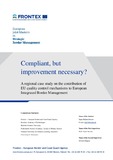| dc.contributor.author | Højland Jensen, Signe | |
| dc.contributor.other | Nicolau, Paulo, First Supervisor | |
| dc.contributor.other | Rijpma, Jorrit, Second Supervisor | |
| dc.contributor.other | Frontex - European Border and Coast Guard Agency | |
| dc.date.accessioned | 2020-03-11T06:12:40Z | |
| dc.date.available | 2020-03-11T06:12:40Z | |
| dc.date.issued | 2017 | |
| dc.identifier.uri | https://digiriiul.sisekaitse.ee123456789/2436 | |
| dc.description | 1. Introduction ; 2. Methodological framework ; 2.1. Research strategy ; 2.2. Research design ; 2.3. Data collection and use of data ; 2.4. Data analysis ; 2.5. Research quality indicators ; 3. Quality control mechanisms in European Integrated Border Management ; 3.1. Institutionalising European Integrated Border Management as the common strategic framework ; 3.2. The development of the Schengen evaluation mechanism ; 3.3. The Schengen evaluation mechanism in practice ; 3.4. Connecting Schengen evaluations to the reintroduction of internal border controls – launch of the nuclear weapon? ; 3.5. Vulnerability assessments – the new kid on the block ; 3.6. Quality control in strategic border management ; 3.7. Continued integration and harmonisation of external border management? ; 4. Applying EU quality control mechanisms in practise: Regional case study of Greece, Italy and Spain ; 4.1. Result of the thematic analysis of Greece, Italy and Spain ; 4.1.1. Unannounced Schengen evaluation of Greece 2015 ; 4.1.2. Announced Schengen evaluation of Greece 2016 ; 4.1.3. Relating the Schengen evaluation of Greece to the overall functioning of the Schengen area ; 4.1.4. Thematic analysis of the announced Schengen evaluation of Italy 2016 ; 4.1.5. Thematic analysis of the unannounced Schengen evaluation of Spain 2015 ; 4.1.6. Thematic analysis of the announced Schengen evaluation of Spain 2017 ; 4.2. Contextualising Schengen evaluation results with key vulnerabilities in external border management ; 4.3. Results of qualitative interviews and replies to the interview guides ; 5. EU quality control mechanisms as drivers for organisational development ; 6. Conclusion and recommendation ; 6.1. Conclusion ; 6.2. Recommendation | et_EE |
| dc.description.abstract | This research reflects that the Schengen evaluations of the EU’s frontline Member States have been significant contributors to verifying and addressing shortcomings in external border management. However, further improvements to the design of the overall quality control system and full implementation of the European Integrated Border Management concept is imperative in strengthening the external borders and protecting the functioning of the Schengen area in a dynamic and ever-changing environment. | et_EE |
| dc.language.iso | en_US | et_EE |
| dc.publisher | Frontex | et_EE |
| dc.subject | Frontex | et_EE |
| dc.subject | Euroopa Liit | et_EE |
| dc.subject | piirivalve | et_EE |
| dc.subject | piirihaldus | et_EE |
| dc.subject | Schengeni leping (1985 ; 1990) | et_EE |
| dc.subject | border guard | |
| dc.title | Compliant, but improvement necessary? : A regional case study on the contribution of EU quality control mechanisms to European Integrated Border Management | et_EE |
| dc.type | Thesis | et_EE |



